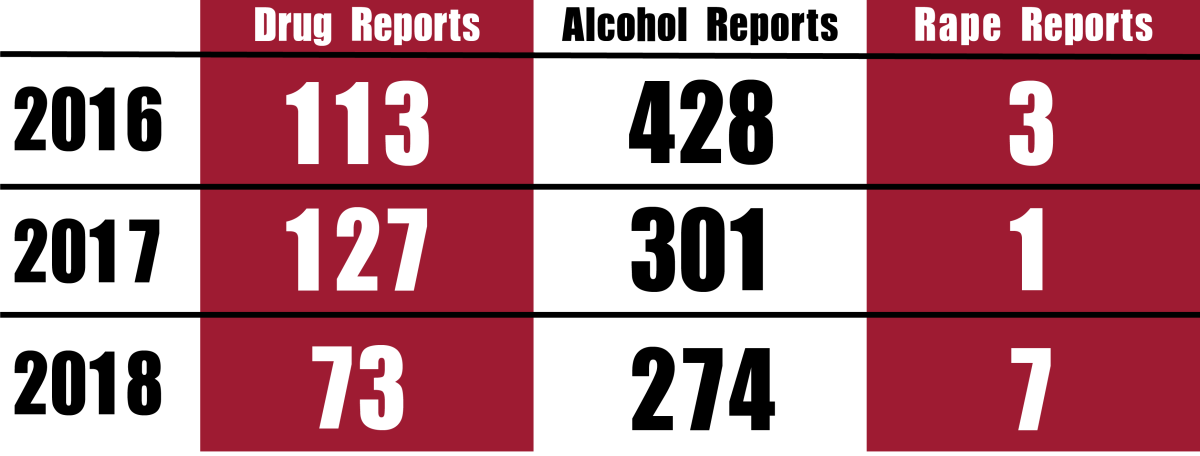The 2019 annual security and fire safety reports released Sept. 30 by St. Joe’s Office of Public Safety and Security show that since 2016 the number of reported alcohol and drug violations in on-campus student housing and facilities has decreased, while the number of reported rapes has increased.
The Jeanne Clery Disclosure of Campus Security Policy and Campus Crime Statistics Act of 1998 requires that campuses like St. Joe’s make their annual security reports available to the campus community and to the public. The report includes statistics on reported sexual assaults, drug and alcohol violations and other instances of crime on and around campus. The purpose of the report is to measure the amount of crime that occurs on a campus in order to inform students, faculty and prospective members of the St. Joe’s community.
According to statistics, the number of reported rapes in on-campus student housing and facilities increased from one in 2017 to seven in 2018. In 2016, there were three reported rapes. Mary-Elaine Perry, Title IX coordinator at St. Joe’s, said the number of reported rapes is typically between eight and 12, but what gets recorded in the annual security report is only on-campus incidents.
“Typically, more assaults occur, more activity that results in the reporting of an assault occurs off campus,” Perry said. “We had more [reports] on campus than off campus [in 2018]. So there were not more reports, they were within the general ballpark, there were just more on campus.”
According to Perry, it isn’t possible to document the exact number of rapes that occur on campus since the fire and safety report only includes rapes that were voluntarily reported by students. Perry said during the campus climate survey done in the spring of 2018, students were asked to say if they had experienced unwanted sexual contact and not reported it.
“Eighty-eight percent said they didn’t report to anyone,” Perry said. “And that’s sad. I want to be able to get them to people that can help them to deal with it, in whatever way they want to deal with it.”
In addition to reports of rape, the fire and safety reports also include drug and alcohol incidents that occur on and around campus.
Marci Berney, director of student outreach and support, said the reports include statistics that show a decline from 2016 to 2018 in the number of alcohol and drug violations.
“We have seen, just through our data, that the numbers look good,” Berney said. “The numbers of students who are either choosing not to drink, or certainly students who are choosing to drink in a more responsible way, are all going in the right direction.”
Berney works with the Wellness, Alcohol & Drug Education Program (WADE) to provide support and education to current and incoming students about safe and responsible alcohol practices. Now, she said there is a new trend of students across the country drinking less, and that data is reflected in the St. Joe’s population.
“Nationally there’s been a bit of a shift and an increase in the number of non-drinkers coming to campuses throughout the country,” Berney said. “The number of students who are not drinking is on the rise, even prior to coming to campus, and we’ve seen the same here at St. Joe’s.”
In the report, Public Safety documented the number of on-campus alcohol incidents in student housing. From 2016 to 2018, the number of on-campus reported alcohol incidents decreased from 428 to 274, and the number of on-campus reported drug incidents decreased from 113 to 73.
Berney said this significant decrease cannot be attributed to a singular variable, but hopes it can be partially attributed to the university’s educational efforts.
“One is the education that students get coming into the university, so both at orientation as well as an online program that students do around alcohol, drugs, including prescription drug use, [and] sexual misconduct,” Berney said.
Ashley Lillie, assistant director of student outreach and support, said the fire and safety report allows students to understand and recognize declines and trends in crime and safety on campus.
“[The report] serves as a great assessment piece for us as well to say there has been a decrease in this, ” Lillie said. “It’s an important piece when we’re looking at all of the things that impact our students and impact their wellness.”













































